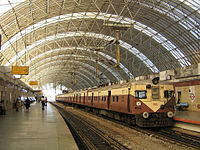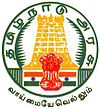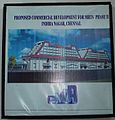- Mass Rapid Transit System (Chennai)
-
Coordinates: 13°05′32″N 80°17′33″E / 13.09233°N 80.29251°E
- For the true metro under construction, see Chennai Metro
Chennai MRTS
சென்னை எம் ஆர் டி எஸ்
Info Owner Southern Railway (India) Locale Chennai (Madras) Transit type Rapid transit Number of lines 1 (Phase I & II) Number of stations 21 (Phase I & II) Daily ridership 76,800[1] Website http://www.southernrailway.gov.in/sutt/mrts.php Operation Began operation 1997 Operator(s) Southern Railway (India) Technical System length 24.715 km (15 mi) [Line 1] Track gauge Broad gauge Electrification 25 kV, 50 Hz AC through overhead catenary System map Legend



0 Chennai Beach 











Rajaji Salai 


1.8 Chennai Fort 





Muthuswamy Road 



2.64 Parktown 

Central and Park 











Pallavan Salai 





Cooum River 





3.53 Chintadripet 





Anna Salai 





5.10 Chepauk 







5.84 Thiruvallikeni 





7.05 Lighthouse 





Radhakrishnan Salai 





Mundakanniamman Koil 







8.73 Thirumayilai 







9.77 Mandaveli 





Kamaraj Salai 





11.09 Greenways Road 





Adyar River 





11.96 Kotturpuram 





Sardar Patel Road 







12.89 Kasturibai Nagar 





13.86 Indira Nagar 







14.72 Thiruvanmiyur 













16.64 Taramani 











17.78 Perungudi 



















19.41 Velachery 





Velachery Road 











Puzhuthivakkam 


24.715 St.Thomas Mount 





Adambakkam 





This route map:
The Chennai MRTS is an elevated line of the urban mass rapid transit system (metro-like cityrail) in Chennai (Madras), India. The line currently runs within the city from Chennai Beach (Madras Beach) to Velachery, covering a distance of 25 km with 21 stations. In spite of full technical and logical separation from the Chennai Suburban Railway, the MRTS is operated by the state-owned Southern Railway, a zone of Indian Railways.
Contents
History
Chennai, India's fourth-largest urban agglomeration, has a well-established suburban railway network, which dates back to 1931, when services began on the metre-gauge line from Beach to Tambaram. Two more suburban services were begun in 1985—Madras Central to Arakkonam and Madras Central to Gummidipoondi, both of which were broad-gauge services.
In the 1980s, the government began planning for a new railway line inside the city. The suburban lines offered no connectivity to Central and South Madras (as Chennai was known then). Planning began in 1985 and construction was started in 1991. The first phase was much delayed and finally opened in 1995, but only upto Chepauk. In 1997, the rest of the stations from Chepauk to Mylapore were completed and services started in 1997. The section of the line encompassing the first 3 stations—Beach, Fort and Park, are at grade; after Park it begins climbing. All the stations after Park—Chintadripet, Chepauk, Tiruvallikeni, Lighthouse and Thirumaylai are elevated. The line from Park to Thirumaylai follows the course of the Buckingham Canal, which runs parallel to the Coromandel Coast.
The second phase of the MRTS connects Thirumaylai with Velachery, a southern suburb. All the stations till Perungudi are elevated. One of the main stations in this stretch is the Thiruvanmiyur Station, which is just across the Tidel Park. The elevated track between Thiruvanmiyur and Velachery was opened to public on 19 November 2007. Further from Velachery station, the work on the third phase is going on and will end in St.Thomas Mount Station, with two stations between Velachery and St.Thomas Mount, namely, Puzhuthivakam and Adambakkam.
Design
Each MRTS station is designed by a different architect and is built to accommodate a full-length EMU (Electric Multiple Unit) rake, possibly consisting of 9 or 12 cars. Currently six-car and nine-car rakes are run on the line, as the traffic on the MRTS Line is considerably less than the three Suburban Lines, where nine and twelve-car rakes run daily. Though the headway is expected once the patronage increases steadily. The MRTS runs from Beach to Velachery in about 40 minutes (compared to 2 hours by road in peak hours for the same distance). The first train from Beach starts at 4:15 am and the last starts at 9:35 pm. In reverse the first train from Velachery starts at 5:00 am and runs till 10.20 pm. MRTS runs a total of 62 pairs (Up and Down) of train on a daily basis on weekdays. But on Sundays it is considerably less. The trains run on the MRTS are 'normal' EMUs, and do not have automatic doors like a Metro train. This is because the MRTS is considered to be an elevated extension of the Suburban Network and not a Metro System, as such. However, the MRTS can be considered a Metro, since it is elevated for the majority of its length, and its services are exclusive, i.e. no other trains run on the MRTS Line.
Corridors
Corridor 1: Chennai Beach (MSB) — St. Thomas Mount (STM) [24.715 km]
Corridor 2: Thiruvanmiyur (TVMR) — MamallapuramIt has been proposed to extend the MRTS corridor from Thiruvanmiyur to Mamallapuram[2]
Corridor 1: Chennai Beach — St. Thomas Mount
Phases
The project involves three phases, of which Phase I and Phase II are completed. Phase II extension is under construction.
Phase Length (elevated) in km Route Stations Cost (Initial Estimate) in crore rupees Sanction Opening Finish Phase I 8.55 (5.80) Chennai Beach - Thirumayilai 8 260 (53.46) 1984 Nov 1, 1995 Oct 19, 1997 Phase II 11.16 (11) Thirumayilai - Velachery 9 665 (733.4) 1998 Jan 26, 2004 Nov 19, 2007 Phase II Ext 5 (5) Velachery - St. Thomas Mount 3 (417) 2007 Exp. 2012 Phase III 16.76 (~10.76) St. Thomas Mount- Villivakkam 10 - - - source:CMDA
Phase II extension
Work on the 5 km, three-station Phase II extension from Velachery to St. Thomas Mount started in 2008, for completion by December 2010.[3] The cost of the project is estimated at Rs. 495.7 crore. However, one of the prime contractors is Maytas Infra, a subsidiary of the troubled Satyam, and Southern Railway has expressed its concern about an apparent halt in work since last 2008.[4]
Phase III and beyond
The planned route for the MRTS will see it turn north after St Thomas Mount and touch the Suburban Line to Arakkonam at Villivakkam before continuing further North East and eventually going down to Grade, i.e. surface level again and merging with the Suburban Line to Gummidipoondi at Tondiarpet.
MRTS take over by CMRL
As of now, Southern Railways operates the MRTS Section. On August 2010, Mr.T.V. Somanathan, Managing Director, Chennai Metro Rail has proposed a plan for take over of MRTS by the Chennai Metro Rail Limited once the Metro becomes operational. Acquisition of MRTS with Chennai Metro will create a single point authority for all the elevated rail networks in Chennai. After the merger, the current MRTS rail stretch will run Advanced rail cars with air-conditioned rakes that have automatic doors and the same will replace all the normal EMUs.[5]
ticket from Thiruvanmiyur to Chennai Beach, for Rs 6
Gallery
Station Models
MRTS Stations
Misc.
Criticism
The MRTS has often come under criticism for poor maintenance, lack of security and no connectivity options with other transit systems. There is also a wastage of floor space in all its stations which was initially planned to be used for commercial purposes.[6][7] In Early 1970s, Madras Area Traffic Study Unit (MATSU) has estimated about six lakh per day patronage by commuters. Currently, only about 70,000 people travel by MRTS making the MRTS a failed project.
The Operational cost of the entire stretch is about Rs.18 lakh per day while revenue generated mounts to only Rs.3 lakh per day. With this, MRTS incurs an annual operational loss of about Rs.54.7 crore. According to the view of Railway officials, the operational loss will be mitigated by execution of Phase II of the project (Thirumalai to Velacherry).[8]
See also
References
- ^ http://www.hindu.com/2009/11/21/stories/2009112160930400.htm
- ^ http://www.cmdachennai.gov.in/Volume1_English_PDF/Vol1_Chapter04_Transport.pdf
- ^ http://www.hindu.com/2008/02/27/stories/2008022759130400.htm
- ^ http://www.maalaimalar.com/asp/news/dis_news_article.asp?artid=307749
- ^ http://www.thehindu.com/news/cities/Chennai/article553984.ece
- ^ http://www.hindu.com/2009/11/21/stories/2009112160930400.htm
- ^ http://www.hindu.com/2009/07/13/stories/2009071358630400.htm
- ^ http://www.thehindu.com/news/cities/Chennai/article553984.ece
External links
{{{1}}} Next station north:
[[{{{2}}}]]Chennai suburban railway : MRTS Next station south:
[[{{{3}}}]]Stop Number:{{{4}}} KM from starting:{{{5}}} These are the stations of Chennai suburban railway - MRTS Chennai Beach | Chennai Fort | Park Town | Chintadripet | Chepauk | Tiruvallikeni | Light House | Mundagakanniamman Koil (u/c) | Thirumayilai | Mandaiveli | Greenways Road | Kotturpuram | Kasturba Nagar | Indira Nagar | Thiruvanmiyur | Taramani | Perungudi | Velachery Urban transit in Chennai Bus Transits Intra-city Expressways Rail Transits * Planned · † Under construction Rapid Rail Transit in India Metro In operationUnder ConstructionChennai Metro · Hyderabad Metro · Jaipur Metro · Kochi Metro · Mumbai Metro · Navi Mumbai Metro · RMRG (Gurgaon)PlannedBhopal Metro · Indore Metro · Kanpur Metro · Ludhiana Metro · Lucknow Metro · MEGA (Gandhinagar & Ahmedabad) · Pune Metro · Patna MetroMonorail Under ConstructionPlannedAhmedabad Monorail · Bangalore Monorail · Chennai Monorail · Delhi Monorail · Indore Monorail · Kolkata Monorail · Navi Mumbai Monorail · Patna Monorail · Pune Monorail · Trivandrum MonorailElevated Rail In operationChennai MRTSTransport in Tamil Nadu Transport by
districtsAriyalur • Chennai • Coimbatore • Cuddalore • Dharmapuri • Dindigul • Erode • Kanchipuram • Kanyakumari • Karur • Krishnagiri • Madurai • Nagapattinam • Namakkal • Nilgiris • Perambalur • Pudukkottai • Ramanathapuram • Salem • Sivagangai • Thanjavur • Theni • Thoothukudi • Tiruchirapalli • Tirunelveli • Tirupur • Tiruvallur • Tiruvannamalai • Tiruvarur • Vellore • Viluppuram • Virudhunagar
Roads National
HighwaysState
HighwaysOther
RoadsEast Coast Road • Rajiv Gandhi Salai / IT Expressway • Chennai Port – Maduravoyal Expressway • Outer Ring Road • Inner Ring Road • Chennai Elevated ExpresswaysPublic
TransportTamil Nadu State Transport Corporation • State Express Transport Corporation • Chennai BRTS • Chennai RBTWRail Southern Railway • Chennai suburban railway • Mass Rapid Transit System (Chennai) • Chennai Metro • Chennai MonorailAirports Chennai International Airport • Tiruchirapalli International Airport • Coimbatore International Airport • Madurai Airport • Salem Airport • Tuticorin Airport • Vellore AirportSeaports Categories:- Railway lines opened in 1997
- Chennai MRTS
- Urban transit in Chennai
Wikimedia Foundation. 2010.























